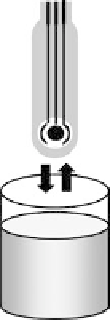Biology Reference
In-Depth Information
Figure 15.1A.
The electrode was washed by dipping once in deionized
water.
0.1
×
saline sodium citrate (SSC) containing 0.5% sodium dodecyl
sulfate (SDS). After the washing step, the SPC was incubated with
horseradishperoxidase(HRP)-conjugatedanti-fluoresceinantibody
diluted in the ratio of 1:200. During this step, the antibody is bound
tothefluorescein-labeledstrandofthePCRamplicons.TheSPCwas
then washed in 0.1
×
SSCcontaining0.5% SDS[8].
AnHRPsubstratewaspreparedcontainingamixtureof3,3
,5,5
-
tetramethylbenzidine and H
2
O
2
in a 1:10 ratio, and this substrate
mixture was applied to the SPC reservoir area to cover the
working, counter and reference electrodes. The enzymatic reaction
occurring on the working electrode was detected using a portable
pulse amperometric reader. The reader used intermittent pulse
amperometry in which a 15 s incubation period was followed by an
applied potential of
−
0.1 V (vs. a silver pseudoreference electrode)
with a measurement time of 10 s and a pulse time of 10 s at a
frequency of 5 Hz anda current range of10
μ
A[8].
15.2.2
Principles of Enzyme-Based PCR Amplicons Target
DNA Detection Methods
15.2.2.1 Direct method
In general, this approach for species-specific identification of
bacterial pathogens involves immobilization of single-stranded









